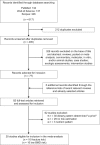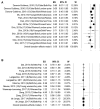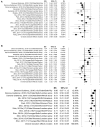Dietary Patterns in Relation to Low Bone Mineral Density and Fracture Risk: A Systematic Review and Meta-Analysis
- PMID: 30657847
- PMCID: PMC6416046
- DOI: 10.1093/advances/nmy073
Dietary Patterns in Relation to Low Bone Mineral Density and Fracture Risk: A Systematic Review and Meta-Analysis
Abstract
Low bone mineral density (BMD) and osteoporosis-related fractures constitute a considerable public health burden. Several studies have demonstrated the association between diet and bone health. We performed a systematic review to provide an estimate of the association between different dietary patterns defined through the use of a posteriori methods and fracture or low BMD risk. A literature search on PubMed, Web of Science, and Scopus databases, up to March 2018, was performed to identify all eligible case-control, prospective, or cross-sectional studies involving subjects of both sexes and any age. Random-effects models were used. Heterogeneity and publication bias were evaluated. Stratified analyses were conducted on study characteristics. The meta-analysis includes 20 studies and identifies 3 prevalent dietary patterns: "Healthy," "Milk/dairy," and "Meat/Western." From the 10 studies on fracture, adherence to the "Healthy" pattern reduced the risk, particularly in older people (OR: 0.79; 95% CI: 0.66, 0.95; P = 0.011) and in Eastern countries (OR: 0.64; 95% CI: 0.43, 0.97; P = 0.037), whereas the risk increased with the "Meat/Western" pattern, especially for older people (OR: 1.11; 95% CI: 1.04, 1.18, P = 0.001), in those with hip fractures (OR: 1.15; 95% CI: 1.05, 1.25; P = 0.002), and in Western countries (OR: 1.10; 95% CI: 1.07, 1.14; P < 0.0001). Analyses on low BMD showed a reduced risk in the "Healthy" pattern, particularly for younger people (OR: 0.62; 95% CI: 0.44, 0.89; P = 0.009). The "Meat/Western" pattern increased low BMD risk, especially in older people (OR: 1.31; 95% CI: 1.05, 1.64; P = 0.015). The "Milk/dairy" pattern resulted in the strongest reduction in low BMD risk; when stratifying, this effect remained significant (e.g., older women-OR: 0.57; 95% CI: 0.46, 0.70; P < 0.0001). Nutrition is an important modifiable factor affecting bone health. The "Healthy" and "Milk/dairy" patterns are associated with a reduced risk of low BMD and fracture. In contrast, the "Western" pattern is inversely associated.
Keywords: bone fracture; bone mineral density; dietary pattern; meta-analysis; systematic review.
© 2019 American Society for Nutrition.
Figures



Comment in
-
Combining Population-Specific Dietary Patterns in Meta-analyses: True or False?Adv Nutr. 2020 Mar 1;11(2):463. doi: 10.1093/advances/nmz071. Adv Nutr. 2020. PMID: 32173749 Free PMC article. No abstract available.
-
Reply to A Salari-Moghaddam et al.Adv Nutr. 2020 May 1;11(3):743. doi: 10.1093/advances/nmz066. Adv Nutr. 2020. PMID: 32419019 Free PMC article. No abstract available.
Similar articles
-
Effects of Milk and Dairy Products on the Prevention of Osteoporosis and Osteoporotic Fractures in Europeans and Non-Hispanic Whites from North America: A Systematic Review and Updated Meta-Analysis.Adv Nutr. 2019 May 1;10(suppl_2):S120-S143. doi: 10.1093/advances/nmy097. Adv Nutr. 2019. PMID: 31089740 Free PMC article.
-
Utilization of DXA Bone Mineral Densitometry in Ontario: An Evidence-Based Analysis.Ont Health Technol Assess Ser. 2006;6(20):1-180. Epub 2006 Nov 1. Ont Health Technol Assess Ser. 2006. PMID: 23074491 Free PMC article.
-
Associations of different dietary patterns, bone mineral density, and fracture risk among elderly women: the China Osteoporosis Prevalence Study.Front Endocrinol (Lausanne). 2024 Jun 12;15:1378158. doi: 10.3389/fendo.2024.1378158. eCollection 2024. Front Endocrinol (Lausanne). 2024. PMID: 38933818 Free PMC article.
-
Dietary patterns explaining differences in bone mineral density and hip structure in the elderly: the Rotterdam Study.Am J Clin Nutr. 2017 Jan;105(1):203-211. doi: 10.3945/ajcn.116.139196. Epub 2016 Nov 30. Am J Clin Nutr. 2017. PMID: 27903522
-
Dietary Patterns and Metabolic Syndrome in Adult Subjects: A Systematic Review and Meta-Analysis.Nutrients. 2019 Sep 2;11(9):2056. doi: 10.3390/nu11092056. Nutrients. 2019. PMID: 31480732 Free PMC article.
Cited by
-
Distinct dietary risk factors for incident osteoporotic fractures in early and late postmenopausal phase women.J Bone Miner Metab. 2023 Mar;41(2):227-238. doi: 10.1007/s00774-023-01400-7. Epub 2023 Jan 30. J Bone Miner Metab. 2023. PMID: 36715763
-
Risk of Environmental Chemicals on Bone Fractures Is Independent of Low Bone Mass in US Adults: Insights from 2017 to 2018 NHANES.Metabolites. 2023 Feb 26;13(3):346. doi: 10.3390/metabo13030346. Metabolites. 2023. PMID: 36984786 Free PMC article.
-
Opposing Effects of Nutritional Supply on Bone Health at Different Ages: Based on the National Health and Nutrition Examination Survey Database.Nutrients. 2024 Mar 7;16(6):758. doi: 10.3390/nu16060758. Nutrients. 2024. PMID: 38542670 Free PMC article.
-
The association of dietary patterns with muscle mass and strength in old age: The Hordaland Health Study.Eur J Nutr. 2023 Oct;62(7):2739-2750. doi: 10.1007/s00394-023-03206-9. Epub 2023 Jul 11. Eur J Nutr. 2023. PMID: 37432471 Free PMC article.
-
The pattern and trends of disease burden due to low bone mineral density from 1990 to 2019 in China: findings from the Global Burden of Disease Study 2019.Arch Osteoporos. 2022 Mar 5;17(1):39. doi: 10.1007/s11657-022-01079-9. Arch Osteoporos. 2022. PMID: 35247103
References
-
- NIH Consensus Development Panel on Osteoporosis Prevention, Diagnosis, and Therapy Osteoporosis prevention, diagnosis, and therapy. JAMA 2001;285:785–95. - PubMed
-
- WHO Scientific Group on the Assessment of Osteoporosis at Primary Health Care Level Summary Meeting Report. [Internet]. Geneva: World Health Organization; 2007. Available from: www.who.int/chp/topics/Osteoporosis.pdf.
-
- National Institute of Arthritis and Musculoskeletal and Skin Diseases NIH Osteoporosis and Related Bone Diseases National Resource Center. [Internet]. 2014. Available from: www.niams.nih.gov/Health_Info/Bone/Osteoporosis/osteoporosis_ff.asp.
-
- Sànchez-Riera L, Carnahan E, Vos T, Veerman L, Norman R, Lim SS, Hoy D, Smith E, Wilson N, Nolla JM et al.. The global burden attributable to low bone mineral density. Ann Rheum Dis 2014;73:1635–45. - PubMed
-
- Becker DJ, Kilgore ML, Morrisey MA. The societal burden of osteoporosis. Curr Rheumatol Rep 2010;12:186–91. - PubMed

